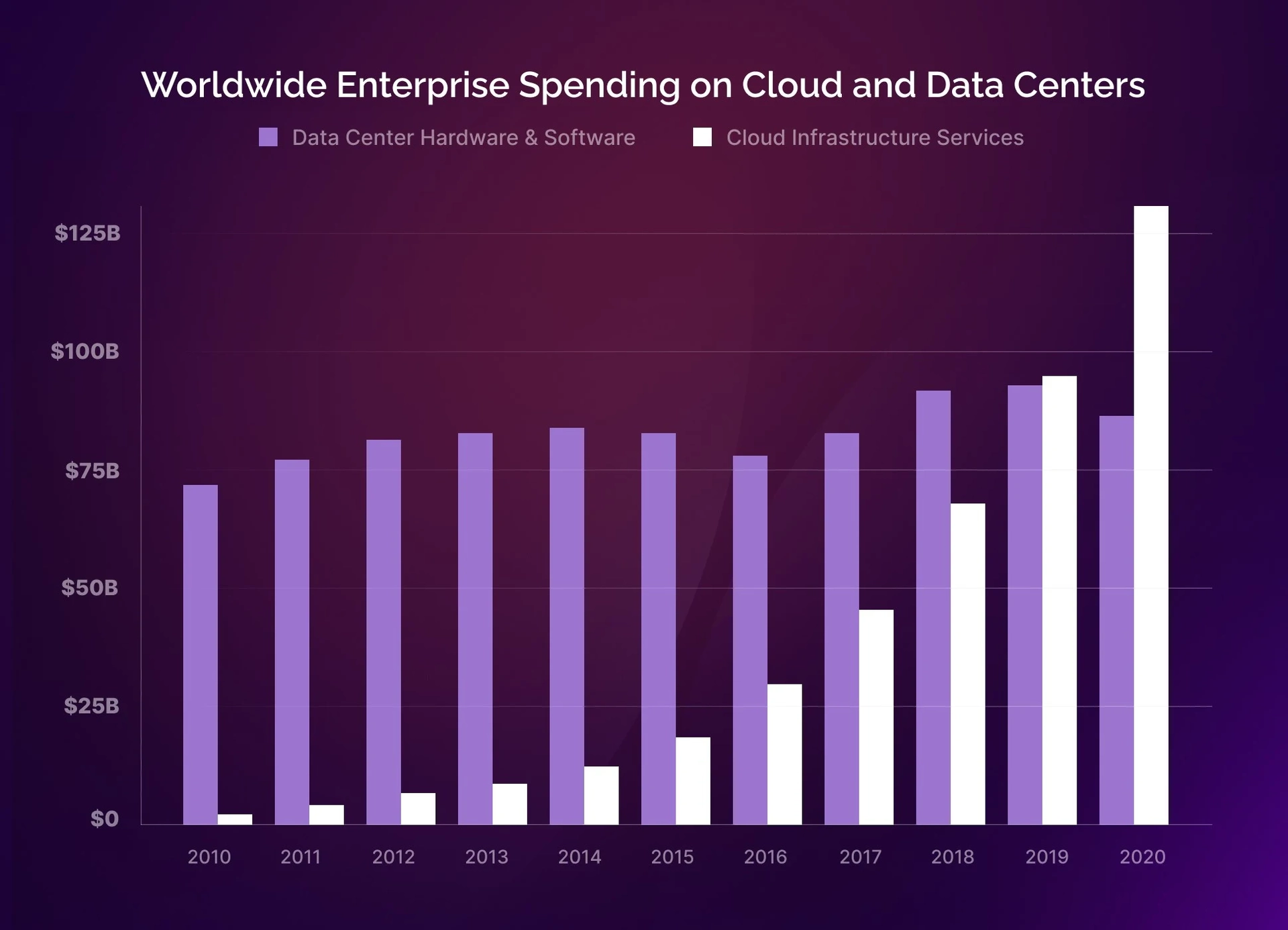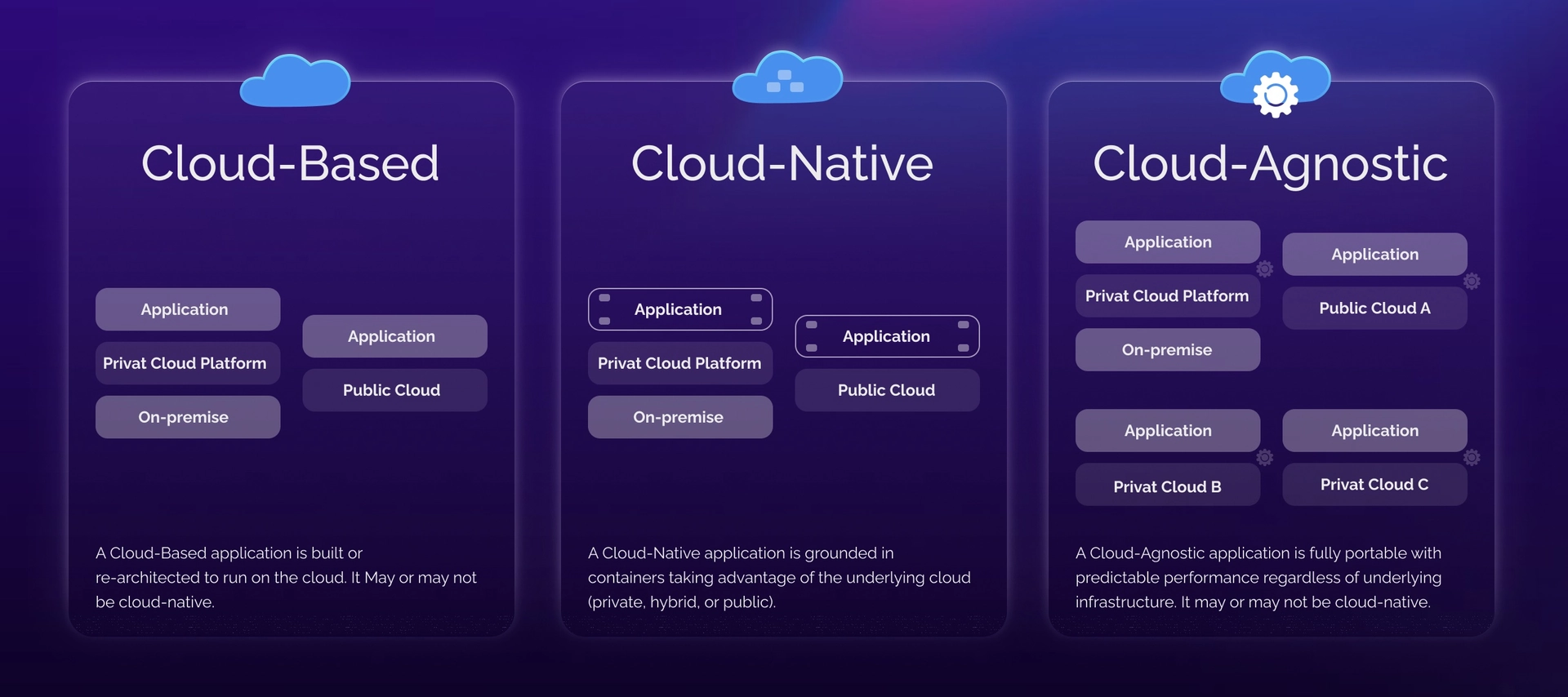The public cloud industry has already seen a yearly investment of over $100 billion. This figure is set to increase in the coming years, as businesses continue to expand their use of cloud-based solutions to meet growing demands. As a result, cloud computing investment is expected to rise significantly in the near future.
Under such circumstances, it is critical for enterprises to stay adaptable, not to be tied to a single supplier, but to be free to select the most lucrative partner. A cloud-agnostic strategy is one of the main approaches to eliminating dependence on a single vendor.
What is Cloud-Agnostic Strategy?
A cloud-agnostic strategy allows companies to create and manage their systems and applications such that they can run and be maintained on any cloud platform rather than being specially built for usage on a single platform. This method enables enterprises to select the optimal platform for their purposes and, if required, migrate between platforms without having to rebuild their systems.
Among the primary advantages of this method are the following:
-
Avoiding vendor lock-in: One of the primary advantages of a cloud-agnostic strategy is the ability to avoid vendor lock-in, which may be especially essential for enterprises looking to preserve flexibility and control over their systems. Organizations that use numerous cloud providers prevent being bound to a single provider and may simply swap between providers if necessary.
-
Optimizing expenses: Rather than being bound into a single provider with possibly higher rates, a cloud-agnostic strategy can help companies optimize costs by allowing them to take advantage of the cost benefits of each provider. This is especially important for firms with complicated or continuously changing workloads since it will enable them to grow and adapt to changing demands readily.
-
Enhancing flexibility: Rather than being tied to a single provider, a cloud-agnostic strategy may help enterprises improve flexibility by allowing them to pick the best match for their needs. This is particularly crucial for companies with complex or fluctuating workloads, as it enables them to scale up and respond to evolving demands quickly.
-
Controlling risk: Organizations may diversify the risk of depending on a single cloud provider by employing numerous cloud providers. If one provider, for example, has an outage or other interruption, the company can transfer to a different provider to mitigate the damage.
According to Accenture, cloud outages have caused significant downtime in 2020, with the average downtime lasting 117 minutes or nearly two hours. These server issues have significantly impacted organizations, with 98% of surveyed companies reporting that one hour of downtime per year costs them over $100,000. Some 40% of enterprises even reported losing between $1 and $5 million in just one hour of downtime, not including any legal fees, fines, or penalties. As a result, many CIOs are implementing contingency plans, such as adopting hybrid cloud services. Even with the introduction of disaster recovery as a service (DraaS), organizations recognize that a cloud-neutral strategy is key to successful cloud adoption.
-
Remaining competitive: Rather than being confined to the offers of a single provider, a cloud-agnostic strategy may help firms stay competitive by allowing them to take advantage of the newest technologies and developments from each provider. This can assist firms in staying ahead of technology changes.
-
Increasing security: By distributing the risk of a security breach or other interruption among numerous cloud providers, enterprises may strengthen the safety of their systems. This can assist firms in developing more robust and secure systems.
All these benefits are so substantial that according to a report by MarketsandMarkets, the cloud-agnostic market is expected to grow at a compound annual growth rate of 20.2% between 2020 and 2025. However, this approach also has some disadvantages.

Cons of Cloud Agnostic
Since we already spoke about the pros, it's time also to mention some drawbacks:
- Rather than being confined to the offers of a single provider, a cloud-agnostic strategy may help firms stay competitive by allowing them to take advantage of the newest technologies and developments from each provider. This can assist firms in staying ahead of technology changes.
- By distributing the risk of a security breach or other interruption among numerous cloud providers, enterprises may strengthen the security of their systems. This can assist firms in developing more robust and secure systems.
- Another possible downside of a cloud-agnostic strategy is the requirement for integration across several cloud providers. This can be complicated and time-consuming to maintain and may need additional resources and experience.
- While a cloud-agnostic strategy may assist firms in improving system security by spreading the risk of a security breach or other interruption among several providers, it can also raise the risk of a security breach if not adequately managed. For example, if an organization does not ensure each supplier's security, it may be subject to a breach.
Cloud-Agnostic vs. Cloud-Native
It's not completely right to compare cloud native vs. cloud agnostic because those principles actually are not interchangeable and, moreover, can work with each other.
Cloud agnostic means that a system or application can be used on any vendor's platform. This allows enterprises to select the best solution for their needs and transition between providers as needed without having to start from scratch.

Cloud-native, on the other hand, refers to the design and development of systems and applications for the cloud that make use of cloud-specific technologies and architectures. This strategy takes advantage of the cloud's unique capabilities and benefits to create and deploy apps more efficiently and effectively. Cloud-native apps are frequently built to be highly scalable, robust, and responsive, and they often make use of microservices and other recent architectural principles.
While both strategies can be useful for organizations, they serve different purposes and have distinct characteristics. Cloud-native philosophy aims to build highly resilient and scalable systems that can quickly adapt to changing conditions and workloads. On the other hand, cloud agnosticism emphasizes flexibility and the ability to change direction, allowing organizations to avoid reliance on a single cloud partner.
Below you can find a comparison of cloud-native and cloud-agnostic design features:
Flexibility
Cloud-agnostic. Developers are not limited to the capabilities or tools of a single cloud platform and can use open-source tools, libraries, and integrations.
Cloud-native. Cloud platforms provide built-in provisions for networking, monitoring, and other underlying architecture concerns that can hinder large development efforts, which can benefit applications.
Implementation
Cloud-agnostic. Implementing a cloud-agnostic approach can be challenging as it must be done at the developer level.
Cloud-native. Successfully implementing a cloud-native approach will require a cultural shift as it represents a new way of thinking.
Portability
Cloud-agnostic. Applications designed to be cloud agnostic can be moved to any provider and are not locked into a specific provider.
Cloud-native. On the other hand, it can be complicated to move applications designed for a specific cloud provider to a different provider.
Expenses
Cloud-agnostic. It has greater access to open-source tools, allowing organizations to have more control over costs and the ability to make adjustments as needed.
Cloud-native. Customers using a pay-as-you-go model are charged based on a combination of licensing and data storage requirements.
Market launch time
Cloud-agnostic. Developing cloud-agnostic applications and features can be complex, which means that it may take longer for projects to get started.
Cloud-native. On the other hand, pre-built templates, tools, and ready-to-use infrastructure can speed up the time it takes for applications to be launched.
Scalability
Cloud-agnostic Apps and services can be moved across cloud platforms, allowing them to scale up to meet demand quickly.
Cloud-native Systems can also easily scale up or down to meet the needs of the business.
Performance
Cloud-agnostic. There is a wide range of features and options customers can use to maximize performance.
Cloud-native. Using components that work on a small segment can improve overall performance.
Resilience
Cloud-agnostic. Applications designed to be cloud agnostic provide redundancy and can improve recovery speed in the event of a failure. If the initial platform experiences a disruption, services can be switched to another platform.
Cloud-native. The use of microservices enables resilience, meaning that a component failure does not have a widespread impact on the overall system.
When choosing between a native and agnostic cloud strategy, it is crucial to consider your organization's specific needs and goals.
If you are designing apps expressly for the cloud and want to exploit the cloud's unique capabilities and benefits to deploy them more efficiently and effectively, the native cloud method may be a smart alternative. Native cloud applications are often built to be highly scalable, robust, and responsive, and they frequently use microservices and other new architectural models.
On the other hand, a cloud-independent strategy may be more suited if you want the flexibility to run and administer systems and applications on any cloud platform rather than being bound to a single provider. This can be useful if you want to be able to choose the most appropriate platform for your needs and switch from one platform to another as needed without having to completely rebuild your systems.
Overall, the right choice for your organization will depend on your specific goals and needs. Evaluating the tradeoffs and considering how well each approach fits your business goals may be helpful.
Best Tools For Cloud-Agnostic Deployment
If you eventually decide to go with a cloud-agnostic approach, look at vendor-neutral solutions that easily scale to disparate systems. Here are some of them:
Jenkins: Jenkins is an open-source automation server that may be used to automate portions of the CI/CD process, such as application development, testing, and deployment. It is a popular choice for enterprises searching for a versatile and adaptable CI/CD solution that can be utilized with a variety of programming languages and technologies. Jenkins may be run on-premises or in the cloud and is compatible with a wide range of tools and services, including version control systems, testing frameworks, and cloud platforms.
GitLab: GitLab is an open-source version control system with CI/CD functionality such as application testing, building, and deployment. It is an all-in-one solution for managing the whole development lifecycle, from project planning and code management through deployment and monitoring. GitLab is available on-premises or in the cloud and supports a diverse set of programming languages and technologies.
Travis CI: Travis CI is a cloud-based continuous integration and delivery platform that supports a broad range of programming languages and may be used to automate application development, testing, and deployment. It is simple to use and works with common version control systems like GitHub and GitLab. Travis CI has a number of features and choices for customizing the CI/CD process, such as support for numerous languages and technologies, as well as integration with a number of tools and services.
CircleCI: CircleCI is a cloud-based CI/CD platform that supports a broad range of programming languages and may be used to automate application development, testing, and deployment. It is intended to be simple to set up and use and interfaces with popular version control systems such as GitHub and Bitbucket. CircleCI provides many features and choices for customizing the CI/CD process, such as support for numerous languages and technologies, as well as integration with a number of tools and services.
It is important to note that while these solutions are vendor-neutral, they may still require some level of integration with specific cloud platforms in order to function properly. It is recommended to carefully evaluate each solution's specific requirements and capabilities to determine which is the best fit for your needs.
How to implement a cloud-agnostic strategy in your company?
Our team has experience working on a variety of cloud projects across multiple industries, including multi-cloud customers with a cloud-agnostic approach. We have qualified cloud specialists on staff who can help you develop cloud-independent applications or migrate existing ones to the cloud. If you are interested in implementing a cloud-agnostic approach in your company, please contact us to discuss the details.

